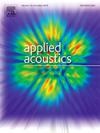Study of ultra-wideband acoustic metamaterial based on multi-order broadband resonance band coupling of ultra-micro perforated panel
IF 3.4
2区 物理与天体物理
Q1 ACOUSTICS
引用次数: 0
Abstract
Ultra-micro perforated panels (UMPPs) have demonstrated exceptional potential for suppressing attenuation in higher-order resonance bands, enabling the design of structurally simple yet highly efficient acoustic absorbers. This study advances the field by introducing series- and parallel-coupled UMPP systems to achieve ultra-wideband sound absorption through the coupling of multi-order resonance bands. The acoustic impedance models for these configurations are developed, along with a detailed framework for calculating sound absorption coefficients. Theoretical investigations explore double- and triple-layer series UMPP structures as well as two- and three-unit parallel UMPP systems, each engineered to broaden the absorption bandwidth through resonance band integration. The influence of key structural parameters, such as cavity depth and perforation dimensions, on absorption performance is systematically analyzed. Experimental validation, conducted using impedance tube measurements for UMPPs with sub-0.1 mm perforations, confirms the accuracy of the theoretical predictions. Results reveal that multi-order wideband resonance coupling in UMPPs with minimal attenuation effects significantly enhances sound absorption bandwidth, offering a robust pathway for practical applications of ultra-wideband acoustic metamaterials in noise control. This study highlights the versatility of UMPP systems in achieving both low-frequency and broadband sound absorption, providing remarkable design flexibility while maintaining structural simplicity.
求助全文
约1分钟内获得全文
求助全文
来源期刊

Applied Acoustics
物理-声学
CiteScore
7.40
自引率
11.80%
发文量
618
审稿时长
7.5 months
期刊介绍:
Since its launch in 1968, Applied Acoustics has been publishing high quality research papers providing state-of-the-art coverage of research findings for engineers and scientists involved in applications of acoustics in the widest sense.
Applied Acoustics looks not only at recent developments in the understanding of acoustics but also at ways of exploiting that understanding. The Journal aims to encourage the exchange of practical experience through publication and in so doing creates a fund of technological information that can be used for solving related problems. The presentation of information in graphical or tabular form is especially encouraged. If a report of a mathematical development is a necessary part of a paper it is important to ensure that it is there only as an integral part of a practical solution to a problem and is supported by data. Applied Acoustics encourages the exchange of practical experience in the following ways: • Complete Papers • Short Technical Notes • Review Articles; and thereby provides a wealth of technological information that can be used to solve related problems.
Manuscripts that address all fields of applications of acoustics ranging from medicine and NDT to the environment and buildings are welcome.
 求助内容:
求助内容: 应助结果提醒方式:
应助结果提醒方式:


